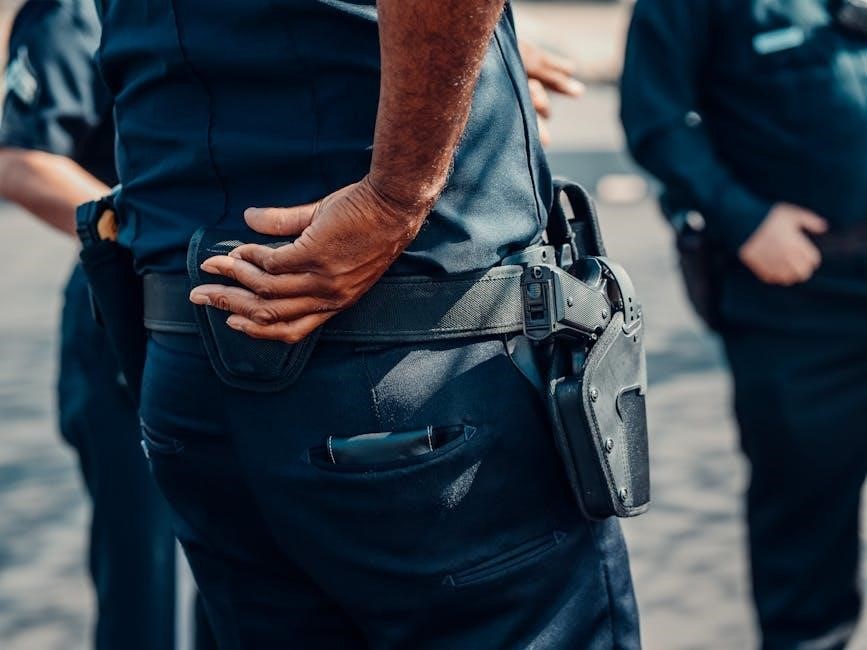
law enforcement phonetic alphabet pdf
The law enforcement phonetic alphabet is a standardized communication system used to clearly transmit information over radio and other communication devices, ensuring accuracy in critical situations.
1.1 Definition and Purpose
The law enforcement phonetic alphabet is a standardized system of codes representing letters and numbers to ensure clear communication, especially in noisy or high-stress environments. Its primary purpose is to minimize misunderstandings during radio transmissions, enabling accurate exchange of critical information such as names, locations, and operational details. This system is essential for maintaining precision and efficiency in law enforcement operations.
1.2 Importance in Communication
The phonetic alphabet is crucial for law enforcement as it enhances clarity in high-stakes communication. By replacing letters with distinct codes, it reduces errors in radio transmissions, especially under noisy conditions. This ensures accurate information exchange, which is vital for officer safety and effective operations. Its universal adoption fosters seamless interagency coordination, making it indispensable in modern law enforcement communication strategies and protocols.

Structure of the Phonetic Alphabet
The phonetic alphabet organizes letters and numbers into distinct codes, ensuring clear communication; Its structured format minimizes errors, promoting efficiency and accuracy in law enforcement operations.
2.1 Letters and Their Corresponding Codes
The law enforcement phonetic alphabet assigns specific codewords to letters, ensuring clear communication. For example, “A” becomes “Alpha,” “B” becomes “Bravo,” and so on. This system replaces letters with distinct, universally recognized words to avoid confusion, especially over unreliable communication channels. Each codeword is carefully chosen to sound unique, reducing errors in critical situations. This structured approach enables quick and accurate identification of letters, making it indispensable for law enforcement operations.
2.2 Numbers in the Phonetic Alphabet
In the law enforcement phonetic alphabet, numbers are spoken clearly to avoid confusion. For example, “one,” “two,” and “three” are used instead of “1,” “2,” and “3.” This system ensures clarity in critical communications, particularly over unreliable channels. Each number is pronounced distinctly to eliminate misunderstandings, making it easier for officers to interpret information accurately during radio transmissions or dispatch calls. This method is crucial for maintaining precision in high-stakes situations.
2.3 Special Codes and Signals
The law enforcement phonetic alphabet incorporates special codes and signals to convey specific meanings quickly. These include codes like “10-4” for acknowledgment and “Code 3” for emergencies. Signals are standardized to ensure all units understand the situation immediately. This system enhances efficiency and safety, allowing officers to react swiftly without confusion. Special codes are integral to maintaining clear and precise communication during operations. They are often updated to reflect evolving law enforcement needs.

Phonetic Alphabet in Law Enforcement Operations
The phonetic alphabet is widely deployed in law enforcement operations to ensure efficient and accurate communication. It plays a crucial role in maintaining clarity and interoperability between agencies.
3.1 Radio Communication Protocols
Radio communication protocols in law enforcement rely heavily on the phonetic alphabet to ensure clear and precise information exchange. Officers use standardized codes and signals to convey messages accurately, especially in high-stress environments. This system minimizes misunderstandings and enhances operational efficiency, making it indispensable for effective coordination and response during critical missions and emergency situations. Proper use of the phonetic alphabet is essential for maintaining seamless communication.
3.2 Use in Dispatch Systems
Dispatch systems in law enforcement utilize the phonetic alphabet to ensure clarity and accuracy when transmitting critical information. This system is particularly vital for relaying names, locations, and incident details over radio and digital platforms. By standardizing communication, it reduces errors and misinterpretations, enabling efficient resource allocation and rapid response. The phonetic alphabet is integral to maintaining seamless coordination between dispatchers and field units, especially in high-pressure emergency scenarios. Its effectiveness enhances overall public safety operations.
3.3 Application in Field Missions
In field missions, the phonetic alphabet is crucial for clear communication among law enforcement personnel. Officers use it to relay precise information, such as suspect descriptions, vehicle identifiers, and tactical instructions, ensuring accuracy in high-stress situations. This standardized system minimizes misunderstandings, enabling effective coordination and swift decision-making. Its application is vital for maintaining officer safety and operational efficiency during pursuits, raids, and other critical operations. The phonetic alphabet remains indispensable in real-time field communications.

Training and Memorization
Training involves memorization techniques like flashcards and repetition. Daily practice enhances proficiency, ensuring accurate communication in critical situations. Testing reinforces retention and readiness.
4.1 Techniques for Effective Learning
Effective learning techniques include using flashcards, repetition, and practice drills. Associating codes with memorable phrases enhances retention. Group study and real-life scenario simulations also improve mastery. Consistency is key to long-term proficiency.

4.2 Daily Practice and Drills
Daily practice and drills are essential for mastering the phonetic alphabet. Officers should dedicate time to reciting codes and engaging in mock radio transmissions. Regular drills with colleagues or using mobile apps can reinforce memory and improve speed. Consistent practice ensures quick recall during high-pressure situations, maintaining clear and accurate communication.
4.3 Testing and Proficiency
Testing and proficiency assessments are crucial to ensure officers master the phonetic alphabet. Regular exams, both written and verbal, help evaluate accuracy and speed. Proficiency is often verified through standardized tests, where officers must correctly encode and decode messages. Achieving high scores demonstrates readiness for real-world applications, ensuring reliable communication in critical law enforcement operations.

Historical Development
The law enforcement phonetic alphabet originated from military communication systems during World War II, evolving to improve clarity in radio transmissions. Over time, it was adapted and refined for law enforcement use, becoming a critical tool for effective and precise communication in high-stakes environments.
5.1 Origins in Military Communication
The phonetic alphabet traces its roots to military communication systems during World War II, where clear radio transmissions were critical for operational success. Developed to reduce errors in relaying letters and numbers, it was initially used by NATO forces. Its effectiveness in noisy environments made it indispensable, later influencing its adaptation for law enforcement. This system ensured precision in communication, becoming a cornerstone for both military and law enforcement operations worldwide.
5.2 Adaptation for Law Enforcement
The phonetic alphabet was adapted for law enforcement to enhance clarity in high-stakes communication. Derived from its military origins, it was tailored to fit policing needs, ensuring precise transmission of names, locations, and incident details. Law enforcement agencies worldwide adopted this system to reduce misunderstandings during radio dispatches and field operations. Its standardized codes help officers communicate effectively, even in noisy or stressful environments, making it a critical tool for public safety and coordination.
5.3 Evolution Over Time
The law enforcement phonetic alphabet has evolved significantly since its military origins. Initially designed for clear radio communication, it was refined to meet policing needs, with updates reflecting modern terminology and technology. Recent advancements include integration with digital systems and mobile apps, enhancing its practicality. The English Style Guide, updated in 2025, highlights its ongoing relevance. This evolution ensures the system remains effective for law enforcement, adapting to new challenges and communication demands.

Benefits of Using the Phonetic Alphabet
The phonetic alphabet enhances clarity, reduces errors in critical situations, and improves interagency coordination. It minimizes misunderstandings, ensuring accurate communication, which is vital for law enforcement operations.
6.1 Enhanced Clarity in Communication
The phonetic alphabet significantly improves communication clarity by assigning unique code words to each letter. This system eliminates confusion caused by similar-sounding letters, ensuring messages are conveyed accurately. It is particularly crucial in high-stress environments where clear communication is essential for effective operations. By using standardized code words, law enforcement personnel can reliably transmit critical information, reducing errors and enhancing overall communication efficiency. This clarity is vital for maintaining operational safety and coordination.
6.2 Reduced Errors in Critical Situations
The phonetic alphabet plays a vital role in minimizing errors during high-stakes operations. By using distinct code words for letters and numbers, it reduces miscommunication caused by similar sounds or poor audio quality. This precision is critical in law enforcement, where even minor errors can lead to operational failures or safety risks. The system ensures clear and accurate transmission of information, safeguarding personnel and enabling effective decision-making in emergency scenarios. Its reliability is indispensable in critical moments.
6.3 Improved Interagency Coordination
The law enforcement phonetic alphabet enhances collaboration among different agencies by providing a standardized communication system. This uniformity ensures that all units, regardless of their jurisdiction or department, can communicate effectively. During multi-agency operations, such as joint task forces or large-scale emergencies, the phonetic alphabet acts as a common language, reducing misunderstandings and fostering seamless coordination. This consistency is crucial for achieving shared objectives and maintaining public safety. Its universal adoption strengthens interagency efforts.

Challenges and Limitations
The phonetic alphabet faces challenges such as regional variations leading to conflicts, technological advancements reducing its relevance, and inconsistent training affecting its effectiveness.
7.1 Regional Variations and Conflicts
Regional variations in the phonetic alphabet can lead to communication conflicts, as different agencies or regions may adopt slightly different codes. For example, “Bravo” in one system might be “Baker” in another, causing confusion during interagency operations. These discrepancies highlight the need for standardized protocols to ensure clarity and consistency across jurisdictions. Additionally, technological advancements sometimes render certain codes less relevant, further complicating universal adoption and effective communication practices.
7.2 Technological Advancements and Relevance
Technological advancements, such as voice recognition software and digital communication systems, have raised questions about the continued relevance of the phonetic alphabet. While automation improves accuracy, it cannot fully replace human judgment in high-stress situations. The phonetic alphabet remains a critical backup system, ensuring reliable communication when technology fails. Its enduring value lies in its simplicity and universality, making it a indispensable tool for law enforcement despite modern innovations.
7.3 Training and Consistency Issues
Consistent training is essential for effective use of the phonetic alphabet, yet variations in teaching methods and regional practices can lead to discrepancies. Officers must memorize and practice regularly to maintain proficiency. Inadequate training can result in errors, especially during high-pressure situations. Standardized protocols and frequent drills are crucial to ensuring all personnel use the system accurately, fostering reliable communication across agencies and jurisdictions. Ongoing education helps mitigate these challenges.

Real-World Applications
The phonetic alphabet is widely used in law enforcement for clarifying letters, numbers, and special codes during radio communications, ensuring clear and efficient information exchange.
8.1 Case Studies and Success Stories
Real-world applications highlight the effectiveness of the law enforcement phonetic alphabet in improving communication accuracy. For instance, during high-stakes operations, officers use phonetic codes to clarify suspect descriptions, vehicle licenses, and locations, minimizing misunderstandings. One notable case involved a multi-agency pursuit where clear communication via the phonetic alphabet facilitated a successful apprehension without confusion. Such examples underscore its critical role in ensuring operational success and officer safety.
8.2 Emergency Response Scenarios
The law enforcement phonetic alphabet is indispensable in emergency response scenarios, where clear communication is critical. Officers rely on it to relay precise information, such as suspect descriptions, vehicle licenses, and locations, minimizing errors. In high-stress situations like active shooter incidents or pursuits, the phonetic alphabet ensures clarity and accuracy, enabling rapid and effective decision-making. Its use is vital for coordinating responses and ensuring officer and public safety during urgent operations.
The law enforcement phonetic alphabet fosters international cooperation by providing a universal communication standard. Agencies worldwide adopt this system to ensure clarity in cross-border operations. During joint missions or global events, the phonetic alphabet bridges language barriers, enabling seamless coordination between international law enforcement teams. Its standardized nature allows for consistent communication, enhancing collaboration and mutual understanding in combating transnational crime and maintaining global security effectively. The phonetic alphabet is integrated into modern technologies like digital systems, AI, voice recognition, and mobile apps, enhancing law enforcement efficiency and real-time communication accuracy globally. The phonetic alphabet is seamlessly integrated into modern digital systems, enhancing law enforcement operations through efficient data retrieval and communication. Software tools and databases now incorporate phonetic codes to ensure accuracy in real-time operations, improving response times and reducing errors. This integration supports advanced search functionalities and automated systems, making critical information more accessible and reliable for officers in the field. Digital systems rely on this standardized communication to maintain clarity and precision. The phonetic alphabet is increasingly utilized in AI and voice recognition systems to enhance accuracy in law enforcement communications. AI-powered tools leverage phonetic codes to improve speech recognition, enabling clearer and more precise interactions. This integration supports real-time transcription and translation, aiding officers in high-stress environments. By minimizing errors in voice commands, AI systems reinforce reliable communication, ensuring seamless operations and faster response times. This technological advancement underscores the enduring relevance of the phonetic alphabet in modern policing. Mobile apps and digital tools have revolutionized the use of the law enforcement phonetic alphabet. These apps often include interactive flashcards, pronunciation guides, and practice exercises, making it easier for officers to memorize and use the codes. Some apps even offer real-time transcription, converting spoken words into phonetic codes instantly. This technology enhances communication efficiency and accuracy, especially in high-stress environments where clear and rapid exchange of information is critically important. The law enforcement phonetic alphabet remains a cornerstone of clear communication, with continuous advancements in technology promising even greater efficiency and accuracy in future operations. The law enforcement phonetic alphabet is a critical tool for clear communication, reducing errors in critical situations; It enhances interagency coordination and is widely adopted due to its standardized structure. Regular training and practice are essential for proficiency. Its historical roots in military use have evolved into a indispensable asset for modern law enforcement operations, ensuring precision and effectiveness in daily tasks and emergency responses. The law enforcement phonetic alphabet is expected to evolve with advancements in technology, integrating with AI and voice recognition systems for enhanced accuracy. Mobile apps and digital tools will likely play a larger role in training and real-time communication. Additionally, there may be efforts to standardize further and adopt more universal codes to improve international collaboration and interoperability among agencies. Effective implementation of the law enforcement phonetic alphabet requires consistent training and adaptation to technological advancements. Agencies must prioritize standardization to ensure seamless communication across jurisdictions. By integrating the phonetic alphabet into daily operations and leveraging digital tools, law enforcement can maintain clarity and accuracy in critical situations. Continuous updates and refinement will be essential to meet evolving demands and enhance interoperability in modern policing.8.3 International Use and Cooperation

Phonetic Alphabet in Modern Technology
9.1 Integration with Digital Systems
9.2 Use in AI and Voice Recognition
9.3 Mobile Apps and Digital Tools
10.1 Summary of Key Points
10.2 Future Developments and Trends
10.3 Final Thoughts on Implementation